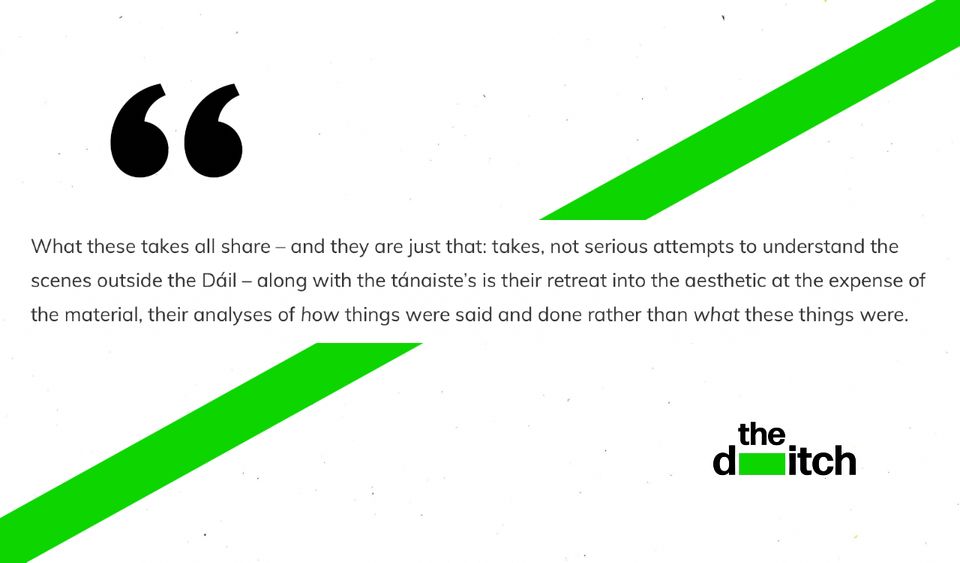Two ideologies: democratic transubstantiation, for which Michael Healy-Rae, upon his election to the Dáil, taking his father’s old seat, ceased being a simple provincial capitalist and was transformed into democracy itself; and democratic consubstantiation, which holds that Healy-Rae, when he became a TD, was imbued with the essence of democracy while retaining his human form.
An attack on Healy-Rae is therefore, for either school of thought, an “attack on democracy”, as ceann comhairle Seán Ó Fearghaíl, housing minister Darragh O’Brien and senator Jerry Buttimer all said in the aftermath of last Wednesday’s far right protest outside Dáil Éireann.
It’s easier to understand some of the reaction to the protest by substituting Michael Healy-Rae for democracy. For Radio Kerry it was “a dark day for Michael Healy-Rae”. Senator Barry Ward wants the gardaí to “step up and protect our Michael Healy-Rae”. Finance minister Paschal Donohoe thinks, “What we saw was a group of people making the case against the very concept of Michael Healy-Rae.” For these people, adherents of these ideologies, Michael Healy-Rae is either democracy or carrier of its essence.
This is parliamentary liberalism, which elevates buildings and TDs to something beyond the physical, to manifestations of our democratic ideals.
Separate to these ideologies is the idea that democracy is more than Michael Healy-Rae, that shoving him around a bit and calling him “worse than a piece of shit” isn’t so much an attack on democracy but rather just an attack on a Kerry TD. The idea that parliamentary liberalism is the peak of democracy is relatively recent. For the US founding fathers and their equivalents in the French Revolution, representative democracy was a means of consolidating elite power rather than empowering populaces.
For these democrats this form of democracy was not about broad representation, but just “representation of particular interests”, as philosopher Jacques Rancière wrote. “‘Representative democracy’ might appear today as a pleonasm. But it was initially an oxymoron.”
The representatives of these elite interests in Dáil Éireann, even if they don’t outright share the same politics as the protestors outside, at times speak in harmony with the far right. Healy-Rae, if he didn’t create a golem certainly encouraged one when he told Kerry media, “When a child is born, they are a boy or a girl and that is it,” and when earlier this year he met with the far right activists responsible for the harassment of librarians across the country, to assure them he’s “traditionalist and conservative”, while discussing children’s education.
'A very, very significant increase in population': tánaiste, far right
On the day of the protest tánaiste Micheál Martin said elements of the agitation “almost approximates to sort of fascist-like behaviour in terms of intolerance, in terms of not allowing people to go in and out of a democratically elected parliament”. Though he made a vague link between the Dáil protest and those at libraries, during which agitators demand the removal of books they don't agree with, his reaction that day concerned not the politics of the protest, but rather its form. For Martin the protest was “fascist like” not because of its ultra-reactionary nature – its extreme anti-immigration and transphobic character – but only because it hindered TDs from going in and out of Leinster House.
This week Martin, having already failed to adequately address the politics of the protest, spoke in terms similar to the protestors, the people for whom “Ireland is full”. Speaking to reporters about Ireland’s upcoming budget, with the country sitting on a surplus of €16 billion, money that people like Martin don’t know how to spend, he warned against optimism.
“It is a very challenging environment with a very, very significant increase in population in the country over the last number of years. If you look over the last two decades, it has been quite dramatic which basically then creates pressure on public services via health, education, childcare,” he said.
He all but agreed with the far right that Ireland is full. To take him at his word, when he spoke of the “very, very significant” population increase in the coming years, he shares the far right’s politics, but not the way they put these politics into practice.
Martin either recognises in the far right a certain congruence with his own party’s support base, or maybe, like many in both government and the national media, he doesn’t understand left-right politics. He has after all written in the Irish Times about what he considers the “the failed and destructive idea that you must conform to the traditional left/right ideology”. (What’s the alternative? A new, secret third way? Groundbreaking).
Irish media when trying to understand the protest at the Dáil arrived at another groundbreaking theory: what if both the left and right are bad. Lining up to tell us this were take-merchants Brenda Power and Matt Cooper in the Irish Daily Mail, Alison O’Connor in the Times Irish edition, Frank Coughlan in the Irish Independent, Kathy Sheridan in the Irish Times, Mick Clifford in the Irish Examiner and Fionnán Sheahan in the Irish Independent. I could tell you to #buyapaper to support their work and to engage with their theories, or I could tell you to buy a cloth and can of deodorant and to engage in some heavy aerosol abuse – it’ll do less damage to your brain in the long term and be more enjoyable in the short.
What these takes all share – and they are just that: takes, not serious attempts to understand the scenes outside the Dáil – along with the tánaiste’s is their retreat into the aesthetic at the expense of the material, their analyses of how things were said and done rather than what these things were.
There was an anti-racist protest in Clondalkin last night. Videos from the demonstration show angry anti-racist activists – and why wouldn’t they be angry – confronting the far right. The activists were shouting. They were shouting, “Refugees are welcome here.” The analysis favoured by the Irish politico-media establishment sees these activists as angry and shouting, chooses not to hear the message that refugees are welcome, and decides these activists are just like the far right.
Actual attacks on actual democracy
The far right does attack Irish democracy. It does so when it uses actual violence, in the burning down of asylum seekers’ camps and refugee accommodation, to seek to alter the ethnic makeup of the country. It does so when it tries to impose its influence on the education of children in Irish schools and when it assaults LGBT people. These are material attacks on people’s fundamental rights, though these attacks don’t inspire the same disquiet as last week’s protest – those subject to them aren’t representatives of the Irish establishment nor the buildings in which they carry out their business.
The last time this building was the scene of a demonstration that caused similar ruling class anxiety was in 2010 when around 50 Sinn Féin supporters, expressing their opposition to the post-crash bailout of Irish banks and the resultant state austerity, made their way through the gates of Leinster House. Bloomberg’s report called the scenes “dramatic” but that was hyperbole. Even The Irish Independent’s Fionnán Sheahan, referring to the protest this week to posit an equivalence between left and right, conceded that the protestors “didn’t really know what to do” once past the gates on Kildare Street.
It makes sense they wouldn’t know what to do. There they were, at the foot of Irish power, the building in which the decision to bail out Irish banks at a cost of €64 billion was made. It’s an incomprehensible figure with a comprehensible decision behind it, made by the Irish government on behalf of its subjects, to “pay unguaranteed bondholders billions of euros for debts that the Irish people have no relation to or no bearing with, primarily to bail out or to ensure the solvency of European banks”, as Vincent Browne put it to the European Central Bank’s Klaus Masuch back in 2012.
If you were exercised to the point of action, any action, by that bailout and what it meant, continues to mean, for the people of Ireland, and were you to make it, seemingly by accident, through the gates of the property where that decision was made, what would you do? There was little these protestors could actually do but stand fecklessly around and shout a few slogans before being manhandled out by members of An Garda Síochána. The deal had long been done.
Rage can be righteous
It was a protest of inarticulate anger, rage even. The same could be said of the protest at Jobstown nine years ago, also repeatedly invoked by establishment forces this week – Christopher Wallace said, “Face it: not guilty” – in arguing that left and right are as bad as each other. But rage can be righteous.
The rage of the protest at Jobstown and Sinn Féin’s anti-bailout demonstration was sparked by state indifference to suffering, to government’s enactment of an austerity programme with the lie that it was a necessity for the good of the state, when really it was little more than an ideological wealth transfer from the bottom of society to the top. These protests were in fact expressions of democracy, of the will of the people, in the face of a democratic deficit. Last week’s protest was driven by ethnonationalism and transphobia imported, ironically, from Britain.
They are not the same.


